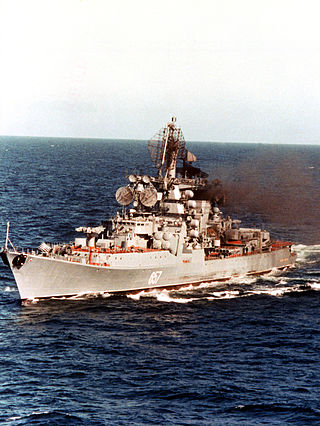Top Qs
Timeline
Chat
Perspective
Kresta II-class cruiser
Soviet guided missile cruisers ship class From Wikipedia, the free encyclopedia
Remove ads
The Kresta II class, Soviet designation Project 1134A Berkut A (golden eagle), was a class of guided missile cruiser (large anti-submarine warfare ship in Soviet classification) built by the Soviet Union for the Soviet Navy. The NATO lists the class as "cruisers" mainly due to the Metel (SS-N-14 Silex) anti-ship missile system capable to strike not only submarines but also surface vessels. They were succeeded by the larger Kara class cruisers.
This article includes a list of general references, but it lacks sufficient corresponding inline citations. (January 2013) |
Remove ads
Design
Summarize
Perspective
The Kresta II class was an anti-submarine derivative of the Kresta I-class cruiser, and were armed with a new anti-submarine missile (SS-N-14), new surface-to-air missiles (SA-N-3) and advanced sonar. Conway's states that the first three ships were to have been armed with the SS-N-9 anti-ship missile but Soviet naval doctrine changed with greater emphasis on anti-submarine warfare. The surface-to-air missiles comprised more advanced SA-N-3 missiles with two twin launchers. New 3D search radar and new fire control radars were also fitted. 4 30mm CIWS guns were also fitted for improved anti-missile defence. A more advanced sonar led to the bow being more sharply raked. The machinery suite comprised two TV-12 steam turbines with high-pressure boilers, identical to the Kresta I class.[citation needed]
General characteristics
The Kresta II-class cruisers were 158.5 metres (520 ft) long with a beam of 16.9 m (55 ft) and a draught of 6 m (20 ft). They displaced 6000 tons standard and 7800 full load. They had a complement of 380-400 and were equipped with a hangar aft to stow away a Kamov Ka-25 Hormone-A helicopter.[1]
Kresta II-class vessels were propelled by two TV-12 steam geared turbines powered by four high pressure boilers which created 75,000 kilowatts (101,000 hp).[1] This gave the cruisers a maximum speed of 34 knots (63 km/h; 39 mph).[1] They had a range of 10,500 nautical miles (19,400 km; 12,100 mi) at 14 knots (26 km/h; 16 mph) and 5,200 nmi (9,600 km; 6,000 mi) at 18 kn (33 km/h; 21 mph).[citation needed]
Armament
For their primary role as anti-submarine cruisers, the Kresta II class mounted two quadruple launchers for eight SS-N-14 anti-submarine missiles. They were also equipped with two RBU 6000 12-barrel and two RBU 1000 6-barrel rocket launchers.[1] The Ka-25 helicopter embarked on the cruiser was also capable of aiding in the search and destruction of submarines.[citation needed]
Against aerial threats the cruisers were armed with four 57mm L/80 DP guns situated in two twin mountings. They also had four 30mm AK-630 CIWS mountings. They were armed with two twin launchers for the 48 SA-N-3 surface-to-air missiles they carried.[1]
The ships also mounted two quintuple mountings for 533 mm (21.0 in) dual-role torpedoes.[1]
Sensors
The Kresta II class were equipped with MR600 air search radar MR-310 Angara Don navigational and Volga navigational radars. For anti-submarine warfare they had MG-322 hull mounted sonar. For fire control purposes they had Grom SA-N-3 fire control, MR103 AK725 fire control and Drakon RP33 fire control. They also had an MG-26 communications outfit and an MG-35 Shtil.[citation needed]
The first four ships of the class to be completed were not equipped with the MR-123 Vympel fire control radar for the AK-630, and relied on manual targeting instead.[2]
Remove ads
Ships
Summarize
Perspective
All the ships were built by the Zhdanov Shipyard in Leningrad.[citation needed]

Remove ads
See also
Notes
References
External links
Wikiwand - on
Seamless Wikipedia browsing. On steroids.
Remove ads

